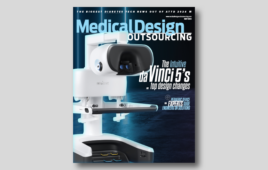
The FibraValve is composed of long filaments of polymer fibers, which replicate the physical properties of a human heart valve and are porous enough to allow cells to infiltrate and replace the scaffold with living tissue. Credit: Wyss Institute at Harvard University
A research team at the Wyss Institute and Harvard’s John A. Paulson School of Engineering and Applied Sciences (SEAS) say they developed a heart valve that can grow with a child, minimizing surgical complications and suffering.
This research team developed a nanofiber fabrication technique to rapidly manufacture heart valves with regenerative and growth potential. They began their work in 2014 and touted the potential of this technology as far back as 2017. Last year, they announced progress using focused rotary jet spinning (FRJS) technology to fabricate heart structures.
The team described the steps taken in a new paper published in Matter. They say they can manufacture their next-generation synthetic heart valve — FibraValve — in less than 10 minutes. The FRJS method allows the researchers to customize the shape and properties of the valve’s delicate flaps down to the nanoscale.
According to the Wyss Institute, the valve was readily colonized by living cells, both in vitro and in large animal model studies. Collaborators led by Wyss Associate Faculty member Simon Hoerstrup conducted the studies at the Wyss Zurich Translational Center in Zurich, Switzerland.
“This study illustrates FibraValves’ potential as a solution for children suffering from valve diseases. Our goal is for the patient’s native cells to use the device as a blueprint to regenerate their own living valve tissue, but FRJS also has potential as a platform to fabricate other medical devices in the future,” said Kit Parker, an associate faculty member at the Wyss Institute and the Tarr Family Professor of Bioengineering and Applied Physics at SEAS.
How the team got here
Rotary jet spinning, the method used to produce the team’s first valve, JetValve, extrudes a biocompatible synthetic polymer through a nozzle, spinning it into long nanofibers. A heart valve-shaped mandrel collects these nanofibers, producing biocompatible valves within minutes. The researchers say other manufacturing efforts require hours to produce valves.
Wyss says the team successfully implanted JetValve into a sheep’s heart using minimally invasive surgery. It functioned properly and recruited living cells to regenerate new tissue on the device. However, the team took steps to enhance several processes around their valve.
In manufacturing, they added streams of focused air to the polymer-extruding stream, creating FRJS. This enabled an improvement in the rate at which polymer fibers turned onto the mandrel. That enhanced the resulting valve, enabling them to manufacture it into the final desired shape. Networks of micro- and nano-fibers produced here also better mimicked the tissue structure of a human heart valve.
Using a new, custom polymer material, the team also improved the infiltration of living cells post-implant. This material, called PLCL, is a combination of polycaprolactone (PCL) and polylactic acid (PLA). The team said previous studies demonstrate that PLCL lasts about six months when implanted into rats. It also was successfully infiltrated by living cells and remodeled into functional tissue before safely biodegrading.
Creating the latest generation of the heart valve
The resulting FibraValves proved softer and more elastic than JetValves, the team said. Additionally, the team optimized the shape of the valve’s inner leaflets. This reduced the amount of leakage of blood backward through the valve. They said leakage went from about 30% in JetValve to 13% in FibraValve.
In a sheep’s heart, FibraValve began to function immediately. After one hour, scientists observed red and white blood cells infiltrating the valve’s porous scaffolding. They also saw a protein, fibrin, deposit onto the outside of the valve, while the valve displayed no damage or problems post-implant.
“It was very exciting to see the FibraValve functioning in vivo, especially since we were coordinating across an ocean with our colleagues in Zurich to make it happen,” said co-first author Michael Peters, a graduate student at the Wyss Institute and SEAS. “This approach to heart valve replacement might open the door towards customized medical implants that regenerate and grow with the patient, making children’s lives better.”
The team aims to begin longer-term animal testing to evaluate FibraValve’s performance and regenerative capabilities over weeks and months. They hope FRJS could offer suitability in a variety of implantables, including other valves, cardiac patches and blood vessels.




